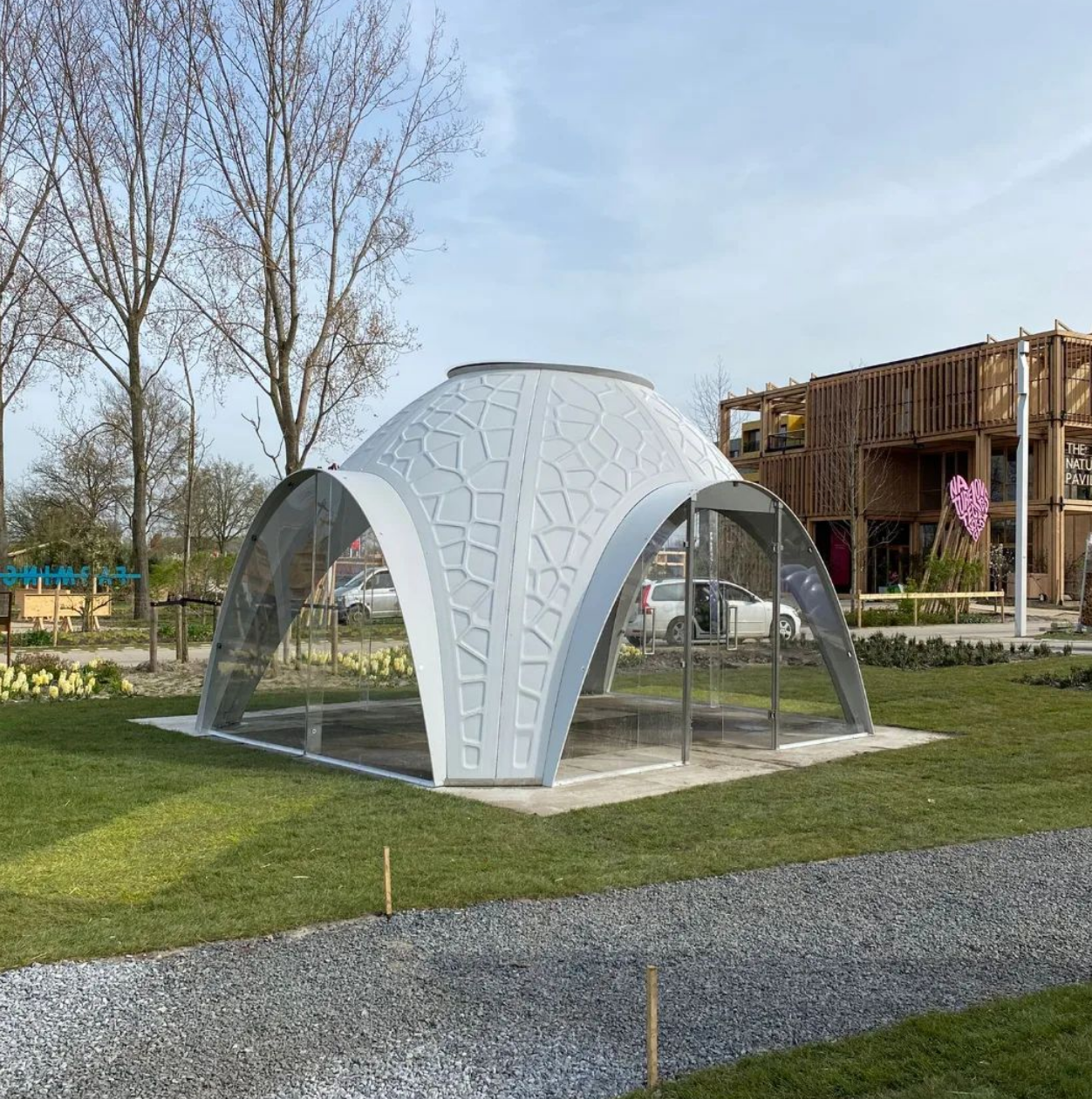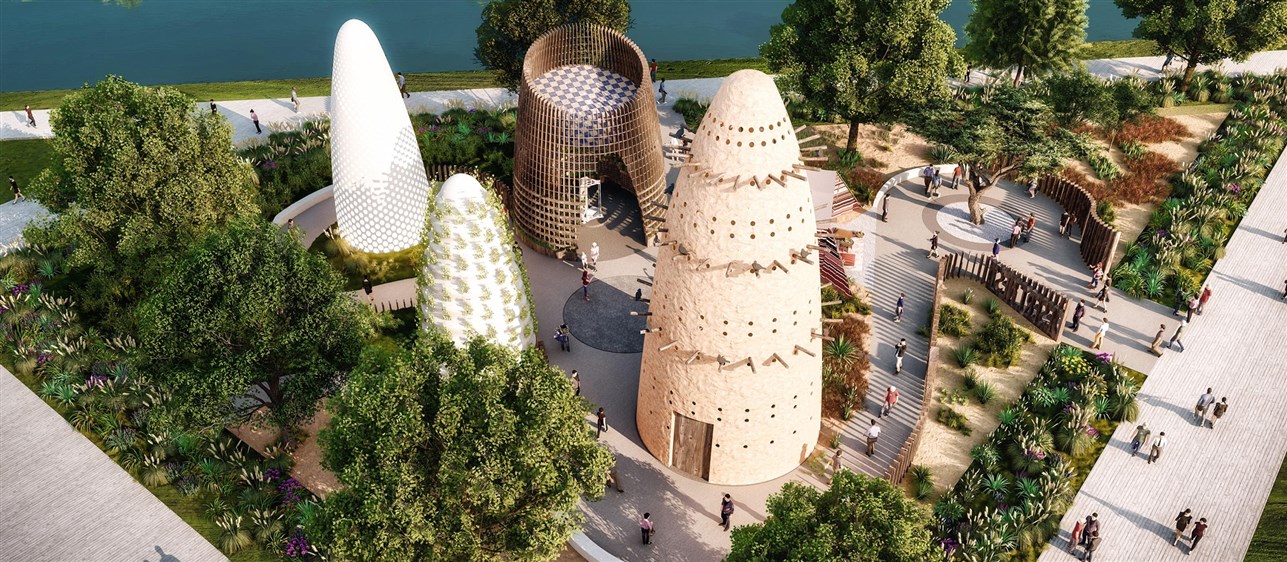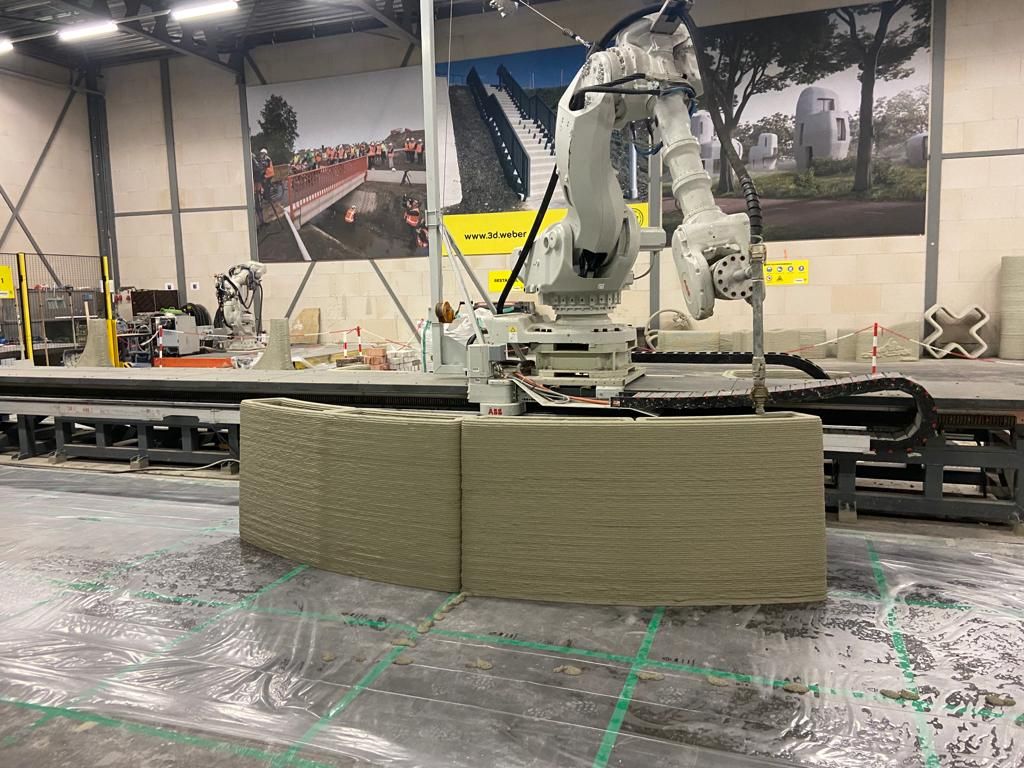It’s a green city of the future at the Floriade Expo 2022. This large-scale world horticulture exhibition, which takes place once every ten years in the Netherlands, sets the stage for the future of sustainable living. Considered one of the world’s major horticultural shows, the Floriade Expo is held in Almere from April 14 through October 9, 2022. Labeled as a green event, it offers visitors a lush refuge of flowers, plants, vegetables, and fruits in park-like surroundings, where they can enjoy a wide array of innovations, vibrant arts, and culture.
Amid a living library of plants designed by landscape architect Winy Maas, forty country presentations and pavilions, and a real aerial cableway that runs across the expo’s 60-hectare-park, several 3D printed marvels stand out. From Qatar’s 3D printed buildings shaped like age-old pigeon towers to a portable, sustainable, 3D printed workspace, each gives visitors a taste of what the technology can do to enhance city life.
In the exhibit’s “Urban District” area, dozens of countries showcase their solutions to the major urban challenges of the future. Qatar chose to display four one-of-a-kind sustainable construction prototypes as beautiful and pragmatic architectural structures. Each tower in the pavilion’s 2,000-square-meter plot has its own story and was built with different materials and techniques. There’s an “Energy Tower,” “Legacy Tower,” and “Vertical Garden.” However, the “Pigeon Tower” is what most interests us since its 3D printed. Relying on the advanced manufacturing technology and sustainable materials, Qatar pays tribute to the traditionally built pigeon coop towers in the country, also known as Burj al-Hamam in Arabic.
This modern version of the dovecote is both visually beautiful and practical. Like its predecessors, the 3D printed tower provides shelter for more than a thousand pigeons during the migration season and consequently delivers ecological farming. Owing to the clever construction, pigeon droppings can be collected and used as fertilizer for local farms. Since many wild pigeons now use the tower, visitors can go up close to the 3D printed construction (at their own risk).
Designed by Wittteveen+Bos and the Expo Pavillion Group, the “Pigeon Tower” was printed by Saint-Gobain Weber Beamix at its recently acquired construction company BAM in the Eindhoven Concrete 3D Printing factory. So far, the factory has produced a bicycle bridge, a pedestrian bridge, and the first of a series of homes, so this latest tower is among the first 3D printing undertakings by Saint-Gobain, and thanks to its 12.1 meters, it is one of the highest concrete 3D printed objects in the world.
The groundbreaking design was built without steel reinforcement or poured concrete. Instead, the 3D printed construction provides an automated way to create the tower design. The tower is built with a total of 66 printed elements and weighs over 63 tons. The top stone alone adds a weight of 3.5 tons to the tower, is built on 11 rings, and closed with the massive end stone holding the construction together. In a sustainable move, Saint-Gobain has considerably reduced the energy requirement of the production process and the amount of material. As a result, up to 60% less carbon dioxide was emitted from building the towers than in traditional construction.
Urban challenges
Described as a “desert nest,” the Qatar Pavilion merges traditional concepts with cutting-edge 3D printing construction methods and sustainable materials. In line with the Expo’s theme of “Growing green cities,” Qatar commissioned the multi-disciplinary consultancy group, Dar, to provide the plot’s advanced concept design, master plan, landscape, and architecture.
The result is what Dar describes as a “legacy of sustainable construction practices, using renewable energy and reclaimed materials, featuring nature-informed parametric design and adaptable landscapes, eliminating construction waste and negative externalities, and employing advanced building practices such as 3D printing.”

Visitors can see the R-Iglo at the Flevo Campus site in the Floriade Expo 2022 in Almere. Image courtesy of Royal3D.
All eyes may be on the Qatar pavilion’s unique structure, but other innovative uses of the technology are also sharing the grounds. For example, visitors wandering through the lush corridors can also see a 3D printed structure called R-Iglo at Flevo Campus, a scientific knowledge hub on urban food issues for the future.
Printed by Royal3D from recycled PET waste material collected from the port of Rotterdam and reinforced with 30% glass fiber, this portable, sustainable, and multi-functional R-Iglo workspace fits any demand and location. From an event site to a garden house, exhibition stand, or even beach pavilion, the R-Iglo is quite flexible. It can be manufactured in just a couple of weeks and assembled in two days using a Continuous Fiber Additive Manufacturing (CfAM) printer built for Royal3D by large-scale 3D printer manufacturer CEAD in the Dutch city of Delft.
Outfitted with ventilation, heating, electricity, and LED lighting, this original concept is modular, circular, and locally produced. Moreover, since the construction uses linkable panels of different sizes, the entire pavilion is easily assembled, disassembled, moved, and stored. Owners can even include or remove additional elements to enlarge or reduce the size of the pavilion.

The 3D printed wall of the toilet room called “Restroom Number Two” at the Floriade Expo 2022 in the Netherlands. Image courtesy of Recell
There’s also the UAE Pavilion, a 825-square-meter (8880 sqft) structure that visitors can explore at the event. The pavilion was designed by UAE-based architecture firm Pragma and 3D printed by Dutch design company Aectual. It is described as one of the largest pavilions with 3D printed facades and perimeter walls in the world. The structure features triangular 3D printed blocks that fit together to create a giant jigsaw puzzle. Inside the site’s courtyard is a building constructed from Aectual Weave panels with a custom pattern. These panels are flexible and 3D printed from a plant-based plastic.
Perhaps mort importantly, the 3D printed elements are “fully recyclable” and can be reused for future 3D printing projects. Aectual offers a Circular Service for all of its interior products and architectural systems, so that they can be shredded after use and re-printed into new products. The firm estimates that its production process results in an 80 percent reduction in CO2 emissions compared to traditional building techniques.

The 3D printed UAE Pavilion. Image courtesy of Aectual.
Finally, visitors at the Floriade Expo can also visit “The Exploded View Beyond Building,” a circular and biobased house made with several materials, including Recell, a highly sustainable cellulose-based product derived from unutilized, complex residual streams. One of the most intriguing parts of this house of the future is the wall of “Restroom Number Two,” which was built by Omlab using a 3D printing paste that includes tertiary cellulose from Recell.
Considering that this is a bathroom wall, it was only fitting that Omlab’s 3D paste is made with recovered toilet paper from a sewage treatment plant. Albeit, this material is thoroughly purified before being processed into tertiary cellulose. The application of Recell Compose in the 3D printing paste, together with the other biobased ingredients, ensures a circular, constructively strong, and multi-usable material that is even biodegradable.
Described as a “living lab” by Recell, this full-size home installation is fully circular and constructed from biomaterials and provides a unique site where visitors can see and experience what is possible with the current state of technology and knowledge.
Floriade Expo 2022 has sustainability written all over. Furthermore, the expo includes some permanent buildings and innovative infrastructure, which will be used to create an innovative, sustainable residential area called Almere Hortus once the event ends. Also, an art pavilion built in the heart of the expo will be reconverted into an art museum and become one of the key attractions of the new neighborhood.
Subscribe to Our Email Newsletter
Stay up-to-date on all the latest news from the 3D printing industry and receive information and offers from third party vendors.
Print Services
Upload your 3D Models and get them printed quickly and efficiently.
You May Also Like
Reinventing Reindustrialization: Why NAVWAR Project Manager Spencer Koroly Invented a Made-in-America 3D Printer
It has become virtually impossible to regularly follow additive manufacturing (AM) industry news and not stumble across the term “defense industrial base” (DIB), a concept encompassing all the many diverse...
Inside The Barnes Global Advisors’ Vision for a Stronger AM Ecosystem
As additive manufacturing (AM) continues to revolutionize the industrial landscape, Pittsburgh-based consultancy The Barnes Global Advisors (TBGA) is helping shape what that future looks like. As the largest independent AM...
Ruggedized: How USMC Innovation Officer Matt Pine Navigates 3D Printing in the Military
Disclaimer: Matt Pine’s views are not the views of the Department of Defense nor the U.S. Marine Corps Throughout this decade thus far, the military’s adoption of additive manufacturing (AM)...
U.S. Congress Calls Out 3D Printing in Proposal for Commercial Reserve Manufacturing Network
Last week, the U.S. House of Representatives’ Appropriations Committee moved the FY 2026 defense bill forward to the House floor. Included in the legislation is a $131 million proposal for...



































